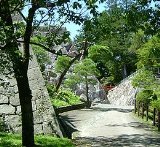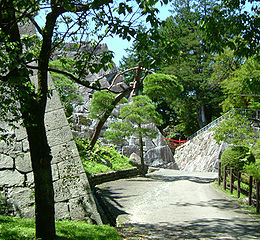
Morioka Castle
Encyclopedia

Morioka, Iwate
is the capital city of Iwate Prefecture, Japan.As of 2005, the city has an estimated population of 300,740 and a population density of 588.11 persons per km². The total area is 489.15 km²....
, Iwate
Iwate Prefecture
is the second largest prefecture of Japan after Hokkaido. It is located in the Tōhoku region of Honshū island and contains the island's easternmost point. The capital is Morioka. Iwate has the lowest population density of any prefecture outside Hokkaido...
, Japan
Japan
Japan is an island nation in East Asia. Located in the Pacific Ocean, it lies to the east of the Sea of Japan, China, North Korea, South Korea and Russia, stretching from the Sea of Okhotsk in the north to the East China Sea and Taiwan in the south...
. Monument
Monument
A monument is a type of structure either explicitly created to commemorate a person or important event or which has become important to a social group as a part of their remembrance of historic times or cultural heritage, or simply as an example of historic architecture...
selected by the country. It was the place of residence of the Nanbu family of Morioka Han. It is also generally called , but strictly saying this indicates another castle.
General information
Morioka Castle is a castle with a continuous enclosure built in a plain mount positioned on a granite hill in the central part of MoriokaMorioka, Iwate
is the capital city of Iwate Prefecture, Japan.As of 2005, the city has an estimated population of 300,740 and a population density of 588.11 persons per km². The total area is 489.15 km²....
. The Kitakami River
Kitakami River
The is the fourth largest river in Japan and the largest in the Tōhoku region. It is 249 kilometers long and drains an area of 10,150 square kilometers. It flows through mostly rural areas of Iwate and Miyagi Prefectures. The river is unusual in that it has two mouths, one flowing south into...
on the west and the Nakatsu River
Nakatsu River
The is a river in Iwate Prefecture, Japan. It flows through the city of Morioka, where it enters the Kitakami River....
on the southeast were its natural outer moats. A secondary enclosure is positioned at the northern part of the inner citadel, and a red painted bridge spans over a moat that divides the two. There's a tertiary enclosure positioned at the northern part of it; a , a and a enclose the inner citadel.
As an act of respect for the shogunate, it has no keep
Keep
A keep is a type of fortified tower built within castles during the Middle Ages by European nobility. Scholars have debated the scope of the word keep, but usually consider it to refer to large towers in castles that were fortified residences, used as a refuge of last resort should the rest of the...
, which was substituted by a three-story turret built on the keep base.
It has an admirable stone wall constructed with white granite, which stands out among the castles of the Tōhoku region
Tohoku region
The is a geographical area of Japan. The region occupies the northeastern portion of Honshu, the largest island of Japan. The region consists of six prefectures : Akita, Aomori, Fukushima, Iwate, Miyagi and Yamagata....
, most of those having earthen forts. The building was dismantled during the Meiji period
Meiji period
The , also known as the Meiji era, is a Japanese era which extended from September 1868 through July 1912. This period represents the first half of the Empire of Japan.- Meiji Restoration and the emperor :...
, and the only known remaining constructions in existence nowadays are a storehouse with thick mortar walls, which was reconstructed in the interior part of the castle, and a gate which is said to have been moved from the castle to the Houon Zen
Zen
Zen is a school of Mahāyāna Buddhism founded by the Buddhist monk Bodhidharma. The word Zen is from the Japanese pronunciation of the Chinese word Chán , which in turn is derived from the Sanskrit word dhyāna, which can be approximately translated as "meditation" or "meditative state."Zen...
shrine within the city. But, it is not sure whether the gate that was reconstructed was the castle gate
Gate
A gate is a point of entry to a space enclosed by walls, or a moderately sized opening in a fence. Gates may prevent or control entry or exit, or they may be merely decorative. Other terms for gate include yett and port...
.
Nowadays, the ruins of the Morioka Castle became the (see below for more information about its nickname ). Within the park, there is a monument inscribed with a poem of Kenji Miyazawa
Kenji Miyazawa
was a Japanese poet and author of children's literature in the early Shōwa period of Japan. He was also known as a devout Buddhist, vegetarian and social activist.-Early life:...
, who hailed from there and utterly loved the castle. Also, a monument in memory of Takuboku Ishikawa
Ishikawa Takuboku
was a Japanese poet. He died of tuberculosis. Well known as both a tanka and 'modern-style' or 'free-style' poet, he began as a member of the Myōjō group of naturalist poets but later joined the "socialistic" group of Japanese poets and renounced naturalism.-Major works:His major works were two...
can be found, inscribed with one of his poems that is:
History
As stated above, the castle was the residence of the Nanbu clanNanbu clan
The ' was a Japanese samurai clan originating in northern Japan, specifically Mutsu Province . The Nanbu claimed descent from the Minamoto clan, and its members first enter the historical record as residents of Kai Province during the Kamakura period. The clan later moved to Mutsu...
, and the seat of Morioka han during the Edo period
Edo period
The , or , is a division of Japanese history which was ruled by the shoguns of the Tokugawa family, running from 1603 to 1868. The political entity of this period was the Tokugawa shogunate....
. It was held by the Nanbu until just after the Boshin War, when the family was reassigned by the government to Shiroishi Castle
Shiroishi Castle
is a Japanese castle in Shiroishi, Miyagi, within what was Mutsu Province. It was the castle of the Katakura clan, which was a family of retainers serving the Date clan of Sendai...
, which was formerly in the Sendai domain.
External links
- http://www.city.morioka.iwate.jp/09tosi/koen/midori/iwate.html (In Japanese) - Iwate Park

